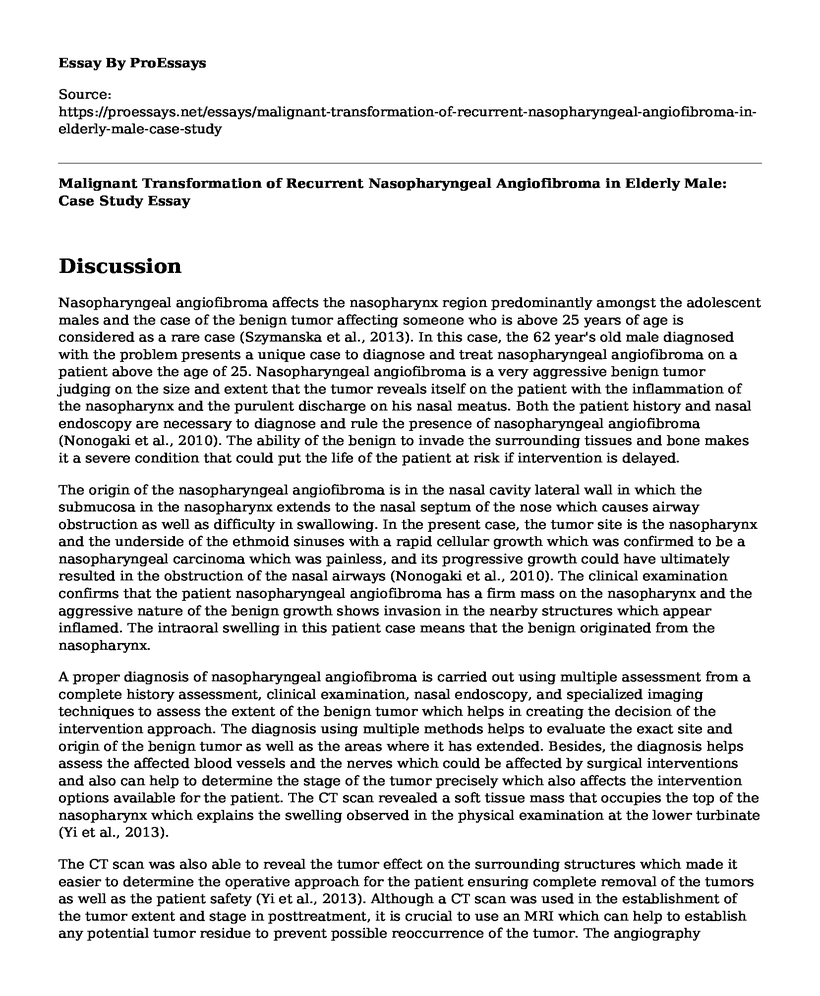Discussion
Nasopharyngeal angiofibroma affects the nasopharynx region predominantly amongst the adolescent males and the case of the benign tumor affecting someone who is above 25 years of age is considered as a rare case (Szymanska et al., 2013). In this case, the 62 year's old male diagnosed with the problem presents a unique case to diagnose and treat nasopharyngeal angiofibroma on a patient above the age of 25. Nasopharyngeal angiofibroma is a very aggressive benign tumor judging on the size and extent that the tumor reveals itself on the patient with the inflammation of the nasopharynx and the purulent discharge on his nasal meatus. Both the patient history and nasal endoscopy are necessary to diagnose and rule the presence of nasopharyngeal angiofibroma (Nonogaki et al., 2010). The ability of the benign to invade the surrounding tissues and bone makes it a severe condition that could put the life of the patient at risk if intervention is delayed.
The origin of the nasopharyngeal angiofibroma is in the nasal cavity lateral wall in which the submucosa in the nasopharynx extends to the nasal septum of the nose which causes airway obstruction as well as difficulty in swallowing. In the present case, the tumor site is the nasopharynx and the underside of the ethmoid sinuses with a rapid cellular growth which was confirmed to be a nasopharyngeal carcinoma which was painless, and its progressive growth could have ultimately resulted in the obstruction of the nasal airways (Nonogaki et al., 2010). The clinical examination confirms that the patient nasopharyngeal angiofibroma has a firm mass on the nasopharynx and the aggressive nature of the benign growth shows invasion in the nearby structures which appear inflamed. The intraoral swelling in this patient case means that the benign originated from the nasopharynx.
A proper diagnosis of nasopharyngeal angiofibroma is carried out using multiple assessment from a complete history assessment, clinical examination, nasal endoscopy, and specialized imaging techniques to assess the extent of the benign tumor which helps in creating the decision of the intervention approach. The diagnosis using multiple methods helps to evaluate the exact site and origin of the benign tumor as well as the areas where it has extended. Besides, the diagnosis helps assess the affected blood vessels and the nerves which could be affected by surgical interventions and also can help to determine the stage of the tumor precisely which also affects the intervention options available for the patient. The CT scan revealed a soft tissue mass that occupies the top of the nasopharynx which explains the swelling observed in the physical examination at the lower turbinate (Yi et al., 2013).
The CT scan was also able to reveal the tumor effect on the surrounding structures which made it easier to determine the operative approach for the patient ensuring complete removal of the tumors as well as the patient safety (Yi et al., 2013). Although a CT scan was used in the establishment of the tumor extent and stage in posttreatment, it is crucial to use an MRI which can help to establish any potential tumor residue to prevent possible reoccurrence of the tumor. The angiography conducted before the surgery was necessary for identifying the status of the vascular tumors which helped determine the size and the feeding vessels of the tumor (Wu et al., 2011).
The tumor was successfully pulled out and appeared pink and wine colored which indicate that it is highly vascularized. , and in this case, the prognosis is good because the nasopharyngeal angiofibroma was not highly advanced and had not spread in the adjacent structures. Future MRI will be essential to identify and manage possible recurrent tumors to prevent nasopharyngeal angiofibroma recurrence. Studies have found out that nasopharyngeal angiofibroma regresses over a period time, but periodic imaging will be necessary for this patient to avoid recurrence (Spielmann et al., 2008).
References
Nonogaki, S., Campos, H. G., Butugan, O., Soares, F. A., Rotea Mangone, F. R., Torloni, H., & Mitzi Brentani, M. (2010). Markers of vascular differentiation, proliferation and tissue remodeling in juvenile nasopharyngeal angiofibromas. Experimental and therapeutic medicine, 1(6), 921-926.
Spielmann, P. M., Adamson, R., Cheng, K., & Sanderson, R. J. (2008). Juvenile nasopharyngeal angiofibroma: spontaneous resolution. ENT: Ear, Nose & Throat Journal, 87(9).
Szymanska, A., Szymanski, M., Morshed, K., Czekajska-Chehab, E., & Szczerbo-Trojanowska, M. (2013). Extranasopharyngeal angiofibroma: clinical and radiological presentation. European Archives of Oto-Rhino-Laryngology, 270(2), 655-660.
Wu, A. W., Mowry, S. E., Vinuela, F., Abemayor, E., & Wang, M. B. (2011). Bilateral vascular supply in juvenile nasopharyngeal angiofibromas. The Laryngoscope, 121(3), 639-643.
Yi, Z., Fang, Z., Lin, G., Lin, C., Xiao, W., Li, Z., ... & Zhou, A. (2013). Nasopharyngeal angiofibroma: a concise classification system and appropriate treatment options. American journal of Otolaryngology, 34(2), 133-141.
Cite this page
Malignant Transformation of Recurrent Nasopharyngeal Angiofibroma in Elderly Male: Case Study. (2022, Nov 04). Retrieved from https://proessays.net/essays/malignant-transformation-of-recurrent-nasopharyngeal-angiofibroma-in-elderly-male-case-study
If you are the original author of this essay and no longer wish to have it published on the ProEssays website, please click below to request its removal:
- Argumentative Essay on Organ Transplant and Donation
- Paper Example on Infectious Diseases
- Application for the School of Nursing
- Skeletal Muscle, Myokines, Obesity and Exercise Paper Example
- Essay Sample on Invisible Chronic Illnesses
- Dana-Farber's Case Study
- Navigating Covid Crisis: A Decision-Making Model - Essay Sample







